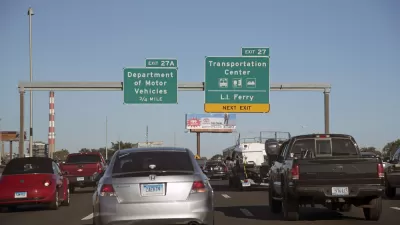Connecticut Governor Dan Malloy sees potential benefits in economic development and congestion reduction in a pair of highway widening proposals in his state.
Heather Brandon reports that Connecticut Governor Dan Malloy has hit the road to stump for a plan to add lanes to part of I-84 and the length of I-95 in the state.
A soundbite from Gov. Malloy quoted in full in the article claims a dramatic multiplier effect from the highway widening projects: "Adding travel lanes in both directions on I-95 from Greenwich to North Stonington, and on I-84 between the areas of Waterbury and Danbury, would provide economic benefits to our state of nearly 40 billion dollars -- about four times the cost of widening those two highways," Gov. Malloy said. Unmentioned are the likely effects of ongoing maintenance costs or long-term externalities like pollution on the size of that multiplier.
The article begins with an interesting take on induced demand (in this case defined as "a term economists use to describe how a bigger supply of a good thing can make people want more of it"), which says that Gov. Malloy is "banking" on induced demand rather than neglecting to consider the long-term effects of induced demand. Gov. Malloy himself implies the latter: his second talking point in favor of widening the highways is as a congestion reduction measure. Eventually, Brandon quotes Charles Marohn, founder of Strong Towns, to counter that argument, and explain the possible futility of the project as a congestion reduction measure.
In an earlier article, Joseph Cutrufo described a double standard afforded highway widening projects by the media.
FULL STORY: Gov. Malloy: Widening Highways Is Good for the State Economy

Planetizen Federal Action Tracker
A weekly monitor of how Trump’s orders and actions are impacting planners and planning in America.

San Francisco's School District Spent $105M To Build Affordable Housing for Teachers — And That's Just the Beginning
SFUSD joins a growing list of school districts using their land holdings to address housing affordability challenges faced by their own employees.

The Tiny, Adorable $7,000 Car Turning Japan Onto EVs
The single seat Mibot charges from a regular plug as quickly as an iPad, and is about half the price of an average EV.

As Trump Phases Out FEMA, Is It Time to Flee the Floodplains?
With less federal funding available for disaster relief efforts, the need to relocate at-risk communities is more urgent than ever.

With Protected Lanes, 460% More People Commute by Bike
For those needing more ammo, more data proving what we already knew is here.

In More Metros Than You’d Think, Suburbs are Now More Expensive Than the City
If you're moving to the burbs to save on square footage, data shows you should think again.
Urban Design for Planners 1: Software Tools
This six-course series explores essential urban design concepts using open source software and equips planners with the tools they need to participate fully in the urban design process.
Planning for Universal Design
Learn the tools for implementing Universal Design in planning regulations.
Smith Gee Studio
City of Charlotte
City of Camden Redevelopment Agency
City of Astoria
Transportation Research & Education Center (TREC) at Portland State University
US High Speed Rail Association
City of Camden Redevelopment Agency
Municipality of Princeton (NJ)



























